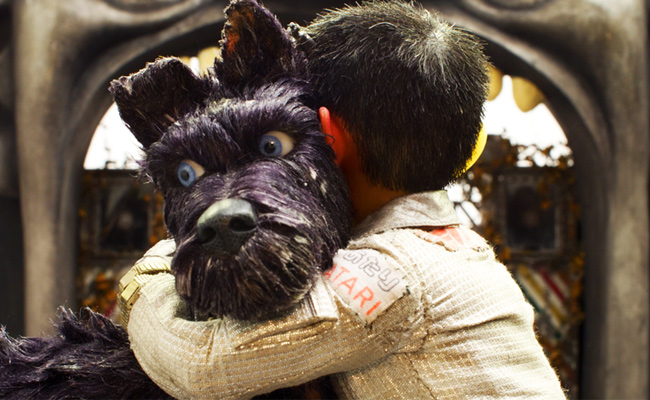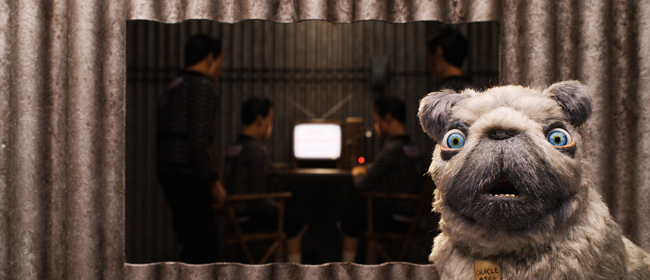
Animation suits Wes Anderson’s style. Especially later-career Wes Anderson, as his compositions get more and more ornate and his blocking and camera moves get more specific, his cuckoo clock style has a way of turning the actors into cogs in a Rube Goldberg machine (and my God, does Wes Anderson ever enjoy machines). Which can make them seem a little stiff, even in comparison to the actors in his more loosely staged earlier work like Rushmore. The beauty of Isle of Dogs and its stop-motion animation is that Anderson can just stick the characters wherever he needs them. He doesn’t have to worry about making them seem stiff, they’re already stick figures. Freed from the responsibility of working with other humans in the room, he can do more of what he really wants, like build anachronistic punch-card computers and stage cutesy action setpieces on vaguely European gondola rides. It’s a winning formula.
In that sense, Isle of Dogs, a stop-motion comedy about the dogs of Megasaki (in Uni Prefecture) who are banished to Trash Island by the cat-loving Mayor Kobayashi, is a perfect fit for Anderson’s style, a series of elaborately staged, simplistically delivered dog jokes, all labeled with yellow text like an old almanac. The elaborate staging and slight subject matter work well together, like an extended animatic for a stylish children’s book — a work that doesn’t need to delve deeply into themes in order to be effective, or affecting. It’s more about rhythm and restraint than passion. (Tellingly, Isle of Dogs‘ human protagonist, Atari Kobayashi (voiced by Koyu Rankin), has a penchant for haiku.) Few other directors’ work feels so much like play. It’s childlike, in a good way. Precocious, with a sense of wonder towards the exotic (it’s the child-like wonder that makes Anderson’s Orientalism feel more curious and admiring than appropriative).
In another way, Isle of Dogs chafes a little under our rigid ideas of what constitutes a “feature film.” It feels like a full-length short — a clear concept, well-executed, a story that can be resolved without too much character evolution or soul-searching. And that’s fine! A lot of times, that’s exactly what we want in a movie: a fresh perspective with minimum commitment. Few directors are better at endings, at tying things up in a neat little bow like Anderson, and Isle of Dogs, like many of his movies, ends strongly enough that you’ll forgive a little narrative floundering in the middle section. He does a fine job making the film just long enough to be traditional feature length without anyone getting too bored. Still, would it really have been so bad if it was only 60 or 70 minutes?
Aside from Kobayashi, the heroes of Isle of Dogs are a group of nobly named Trash Island dogs, Chief (Bryan Cranston), the rough-and-tumble former stray; Rex (Edward Norton), the civilized, take-charge, Ralph-from-Lord Of The Flies type; King (Bob Balaban), a former dog actor from dog food commercials; Boss (Bill Murray), the mascot of a high school baseball team; and Duke (Jeff Goldblum), an upper class snob. As in Fantastic Mr. Fox, the relaxed gravitas of the A-list voice acting is the perfect comedic foil for goofy imagined dog conversations. (Goldblum’s singular syntax is particularly hilarious in this context.) It’s kitsch, certainly, but well done, like if a New Yorker caption contest winner wrote a Dogs Playing Poker movie. Likewise, the level of meticulous craft that so obviously went into each painstaking shot and set only makes the dad-joke simplicity of the one-liners hit that much harder, such as King’s self-pitying declaration “the dogs I like are never in heat.”
Which is to say, Isle of Dogs has bigger laughs than the last few Anderson films, in addition to the usual smiles. The best character is “Oracle,” a pug voiced by Tilda Swinton, whose psychic powers turn out to be less than supernatural. (Oracle’s character design alone is simply sublime.)

Most of Anderson’s now-familiar fetishes remain endearing — machines; jargon; clubhouse-like organizations of children; the rogue-ish creative as protagonist; planes, trains, and automobiles; lists; a fatherly authority figure having a gradual change of heart. His pathological attachment to the prepubescent love story arc, however, remains his most notably off-putting tic. Like Sam and Suzy in Moonrise Kingdom or Agatha and Zero in Grand Budapest, Isle of Dogs stages yet another romance between a young boy in uniform and an unconventionally attractive prepubescent blonde, this time in the form of space-suited Atari and bouffant-sporting American exchange student Tracy Walker (Greta Gerwig). This angle worked in Tenenbaums, but those characters eventually grew up. Does anyone want to watch 12-year-olds play act as newlyweds? At best it’s boring, at worst vaguely pedophilic. Children are not dolls to be played with by adults who want to dress them in fine clothes and see them smooch. Even weirder, Anderson repeats the kid-with-a-drawn-on-mustache trope he established in Grand Budapest Hotel. One prepubescent kid with a fake mustache works as kitsch. Two, you might have a problem.
On a personal level, Wes Anderson should maybe see a shrink. On an artistic level, he’s as good as he’s ever been. He may not bare his soul in Isle of Dogs, but it’s mostly pretty fun just to watch him play around.
